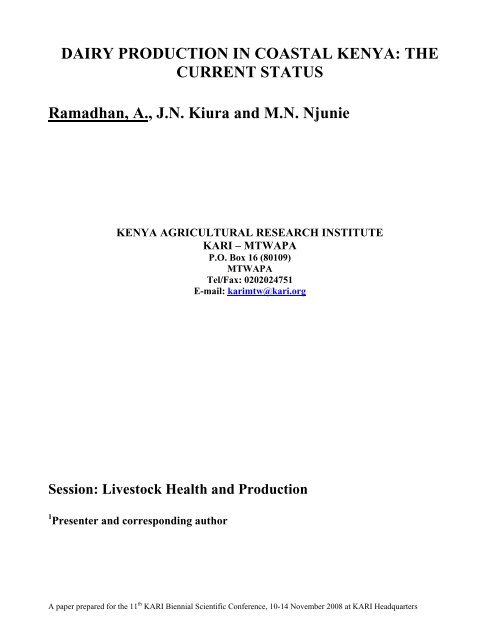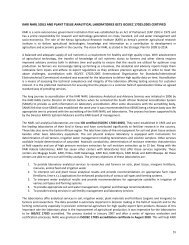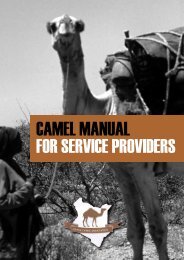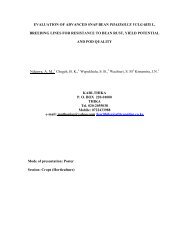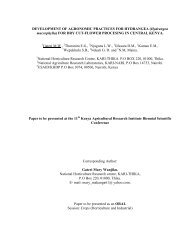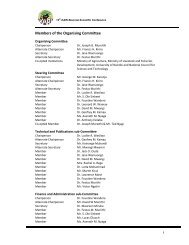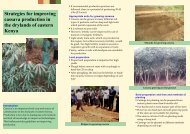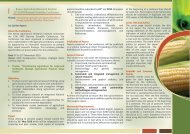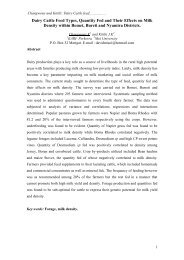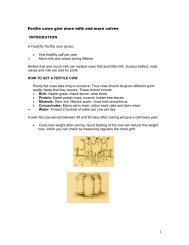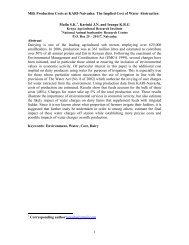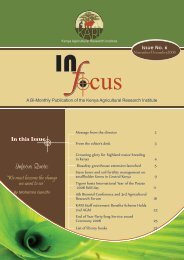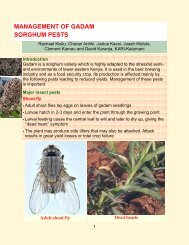DAIRY PRODUCTION IN COASTAL KENYA: THE CURRENT ...
DAIRY PRODUCTION IN COASTAL KENYA: THE CURRENT ...
DAIRY PRODUCTION IN COASTAL KENYA: THE CURRENT ...
Create successful ePaper yourself
Turn your PDF publications into a flip-book with our unique Google optimized e-Paper software.
<strong>DAIRY</strong> <strong>PRODUCTION</strong> <strong>IN</strong> <strong>COASTAL</strong> <strong>KENYA</strong>: <strong>THE</strong><br />
<strong>CURRENT</strong> STATUS<br />
Ramadhan, A., J.N. Kiura and M.N. Njunie<br />
<strong>KENYA</strong> AGRICULTURAL RESEARCH <strong>IN</strong>STITUTE<br />
KARI – MTWAPA<br />
P.O. Box 16 (80109)<br />
MTWAPA<br />
Tel/Fax: 0202024751<br />
E-mail: karimtw@kari.org<br />
Session: Livestock Health and Production<br />
1 Presenter and corresponding author<br />
A paper prepared for the 11 th KARI Biennial Scientific Conference, 10-14 November 2008 at KARI Headquarters
Status of Dairy Production in Coastal Kenya<br />
Ramadhan et. al<br />
<strong>DAIRY</strong> <strong>PRODUCTION</strong> <strong>IN</strong> <strong>COASTAL</strong> <strong>KENYA</strong>: <strong>THE</strong> <strong>CURRENT</strong> STATUS<br />
Ramadhan, A., J.N. Kiura and M.N. Njunie<br />
ABSTRACT<br />
A study to collect livestock baseline information was conducted in Kilifi and Kwale districts of Coast<br />
province in 2006. The aim was to get updated information to enable livestock stakeholders develop<br />
focused interventions on the relevant constraints. Questionnaires were administered to farmers in<br />
coastal lowland (CL) agro-ecological zones 3, 4 and 5 in Kilifi and Kwale districts. Results indicated<br />
that natural pastures was the main source of forage for ruminants. The main cultivated fodder in CLs 3<br />
and 4 was Napier grass. Gliricidia and Clitoria were the main cultivated tree and herbaceous legumes,<br />
respectively. There were no cultivated fodders in CL5, where grazing was free range. For the farmers<br />
keeping livestock, the average number of specific livestock types per farmer was 12 ( ± 2) local cattle,<br />
4 ( ± 0) exotic cattle, and 12 ( ± 1) local goats. Exotic goat numbers ranged from 1 to 10 per<br />
household, with a mean of 4 ( ± 1) goats. Milk production was generally low (1.0-6.4 and 1.0-2.0 kg<br />
day -1 for cattle and exotic/cross goats, respectively). Commercial feed supplements were used by a few<br />
(9.9%) farmers in CLs 3 and 4.<br />
The major constraints to fodder production by farmers were drought, high labour and input costs, lack<br />
of planting material, and lack of technical advice. Water for livestock was a major problem especially<br />
during the dry season. The major diseases for cattle were tick born diseases, worm infestation and<br />
trypanosomiasis. In goats, the major diseases were helminthiasis, tick born diseases and pneumonia.<br />
Key words: Dairy production, forages, constraints<br />
1
Status of Dairy Production in Coastal Kenya<br />
<strong>IN</strong>TRODUCTION<br />
Ramadhan et. al<br />
Market oriented dairy production could be an alternative agricultural activity with higher returns to<br />
land and labour than the traditional export crops, for which policy and markets compel smallholder<br />
farmers in many parts of Africa to diversify, and whose potential growth remains uncertain (Nicholson<br />
et al., 1999). In the Coast province of Kenya, which is a food deficit area, dairy is ranked second to<br />
vegetables as an enterprise with potential for commercialisation (Mwamachi et al., 2005). Cattle are the<br />
main source of milk (‘Start’ document, 2008) though milk goats are also kept by some farmers for milk<br />
production. Farm level milk prices in the area are much higher than those paid in Kenya’s highlands<br />
(Thorpe et al., 1993), and milk and milk products enjoy a strong demand (Nicholson et al., 1999).<br />
Dairy cattle in the coastal region rely on natural pastures (Reynolds et al., 1993), mainly under the free<br />
grazing system (Muinga et al., 1999). Feed quantity and quality are inadequate and rarely meet the<br />
nutrient demands of a lactating dairy cow, especially in the dry season (Reynolds et al., 1993;<br />
Nicholson et al., 1999). The use of commercial concentrates is not popular among the smallholder<br />
dairy farmers (Muinga, 1992). Improving the feed resource will improve milk production and reduce<br />
the gap between the annual milk demand of 181 million litres (Statistical Abstracts, 2007) and<br />
production of 95.3 million litres (Anon, 2007) at the Coast. However, as milk production increases,<br />
regional marketing constraints such as poor infrastructure, have been experienced by farmers when<br />
feeds are plenty (wet season), leading to other constraints that had not been prioritized before. The<br />
existing baseline information for dairy cattle production systems was collected nearly two decades ago<br />
(1989-93) by the KARI-ILCA Project. The information on farming system, fodder and milk<br />
production, feeding system, and market price is bound to have changed over the years. There is need,<br />
therefore, for more recent information in the dairy sector for focussed interventions on the relevant<br />
constraints by stakeholders. The objective of this study was to collect current baseline information for<br />
dairy production systems in Coastal Kenya.<br />
2
Status of Dairy Production in Coastal Kenya<br />
METHODOLOGY<br />
Ramadhan et. al<br />
Nine sites were selected in Kilifi and Kwale districts based on agro-ecological zones (AEZ) as<br />
described by Jaetzold and Schmidt (1983). In Kilifi, the sites were Bahari and Kikambala, in coastal<br />
lowland zone 3 (CL3), Tezo (CL4), and Ganze and Mwanamwinga (CL5). In Kwale, the sites were<br />
Msambweni and Matuga (CL3), Lungalunga (CL4), and Kinango (CL5). The cropping systems in CL3<br />
and CL4 are based on coconut and cashewnut tree crops, with maize and cassava staples intercropped<br />
with cowpeas (Thorpe et al., 1993), while CL5 is a livestock-millet zone. The annual rainfall ranges<br />
from 970 to 1350 mm in CL3 and from 550 to 900 mm in CL5 (Jaetzold and Schmidt, 1983).<br />
A cross-sectional survey on the livestock production enterprise was conducted in 2006 using formal<br />
questionnaires. Livestock extension officers identified the farmers who kept livestock (Lelo et al.,<br />
1995). Stratified systematic sampling (Moser and Kalton, 1974) was used for selecting sites and<br />
respondents. Respondents included 161 livestock farmers; 79 in Kwale and 82 in Kilifi districts.<br />
Interviews were conducted by research and extension staff. Information collected from farmers<br />
included farm size, breeds and numbers of cattle and goats, major crops, cattle feeding method, milk<br />
production by cattle and goats, milk disposal, forages planted, and livestock diseases. Data were<br />
analysed using the General linear model (GLM) procedures of the Statistical Analysis System (SAS,<br />
1997) computer package to obtain descriptive statistics including means, percentages and frequencies.<br />
RESULTS<br />
Respondents<br />
The average age of the farmers was 56 years and was not significantly (P > 0.05) different between the<br />
two districts and among the three AEZs. Only 36% of the farmers had formal education, among whom<br />
24% had primary school education only. More farmers in Kilifi had attained formal education than in<br />
Kwale district (Table 1).<br />
Farming system<br />
The average farm size in the two districts was 9 acres per household. Farmers in Kwale had<br />
significantly (P < 0.05) larger farm sizes (mean 10 acres) than in Kilifi (mean 8 acres) district. On<br />
3
Status of Dairy Production in Coastal Kenya<br />
4<br />
Ramadhan et. al<br />
average, farmers in CL5 had significantly (P < 0.05) larger acreages (mean 10 acres) than in CL3 and<br />
CL4 (mean 4 acres). Eighty percent of land ownership in CL5 was communal compared to 19 and 17%<br />
in CL3 and CL4, respectively. On the other hand, the percentage of freehold (14.3%) and leasehold<br />
(4.8%) ownerships for CL5 was comparatively lower than those of CL3 (59.5 and 20.3%) and CL4<br />
(67.2 and 7.3%), respectively. Only in CL3 was there a settlement scheme, constituting about 1%<br />
ownership. Majority (69%) of the farmers in the three AEZs were full time farmers while the others<br />
had off-farm occupations. Farmers kept more local than exotic/cross cattle and goat breeds. Farmers in<br />
CL5 kept significantly (P < 0.05) more local cattle and goats than in CLs 3 and 4 (Table 2). The<br />
common cattle breeds kept by farmers were Friesian (23% of the farmers), Guernsey (17%), Boran<br />
(17%), and their crosses with small East African Zebu.<br />
Feeds and feeding<br />
Types of fodder<br />
The major fodder crop grown was Napier grass. Forty six percent (46%) of the total farmers sampled<br />
grew Napier grass as a basal feed, all in AEZs CL3 and CL4 (59 and 41% of the farmers, respectively).<br />
Fifty four percent of the farmers (mostly in CL5) used natural pastures only as the basal feed. At the<br />
time of sampling, the Napier grass acreage per household in CL3 was significantly (P < 0.05) higher<br />
than in CL4 (Table 3). The acreage per household in year 2004 was 60% higher than in year 2006. The<br />
main Napier grass cropping system was monocropping (71.6% of farmers). Other cropping systems<br />
included intercropping (23%), alley cropping (2.7%) and boundary planting (2.7%). About 40% of all<br />
the farmers grew fodder legumes, and they were in CLs 3 and 4. There were no farmers growing<br />
legumes in CL5. Leucaena was the most common fodder legume planted, followed by Clitoria (Table<br />
4). Other fodder legumes were Mucuna (4 farmers, mean 0.4 acres), Dolichos (2 farmers, mean 0.6<br />
acres), and Gliricidia. There were 27 ( ± 7) Leucaena and 15 ( ± 3) Gliridicia trees per household farm.<br />
Feeding and source of drinking water<br />
The pattern of grazing for exotic/cross and local breeds of cattle and goats appeared similar in the wet<br />
and dry seasons. About 50% of the farmers in CL3 and CL4 mainly zero-grazed their exotic/cross
Status of Dairy Production in Coastal Kenya<br />
Ramadhan et. al<br />
cattle but grazing was also used by 16.5% of the farmers (Table 5). Local cattle were mainly grazed<br />
while goats (exotic/cross, local) were grazed or tethered. The major roughages basal feeds for<br />
exotic/cross cattle and exotic/cross goats were natural pastures and cultivated fodders (Table 6).<br />
Conserved feeds (silage, hay) were hardly used. No farmer fed cultivated fodders in CL5. About 5-47%<br />
of the farmers fed concentrates to exotic/cross cattle and goats during both the wet and dry seasons,<br />
with concentrate use being more in CL3 than in CLs 4 and 5. The concentrates included maize bran<br />
(26% of the farmers), maize germ (5%), dairy meal (4%) and poultry waste (1%). Livestock accessed<br />
water from wells, rivers, dams and piped water. Distances to rivers were significantly (P < 0.05) longer<br />
in CL5 than in CLs 3 and 4 (Table 7).<br />
Milk production<br />
Fifty four percent and 33% of the exotic/cross and local cattle, respectively, were being milked (Table<br />
8). Only the exotic/cross goats (40% of goats) were being milked. There were more cattle being milked<br />
in CL5 than in CLs 3 and 4 (Table 8). The mean milk production ranged from 1 to 6 kg cow -1 day -1 and<br />
1 to 2 kg day -1 per exotic/cross goat. The local and exotic/cross cattle, and exotic/cross goats produced<br />
less milk per head in CL5 than in CLs 3 and 4 but the difference was not significant (P > 0.05). The<br />
total milk produced per household was similar (P > 0.05) across the AEZs (Table 9). Farmers in CL5<br />
consumed more (P < 0.05) milk in their homesteads than farmers in CLs 3 and 4. The average quantity<br />
of milk sold per household across the AEZs was 5.9 kg day -1 , at an average farm gate price of Ksh 26<br />
per kg -1 .<br />
Constraints<br />
About 3% of the farmers cited unavailability of planting material, inadequate training on fodder<br />
legumes, and death of their dairy cows as the reasons for not following fodder legume recommendation<br />
practices. Drought, labour costs, lack of planting material and lack of technical know-how were<br />
identified as major constraints by 41, 14, 11 and 10% of the respondents, respectively. The major<br />
diseases in decreasing order of importance for cattle were tick born diseases (26%), worm infestation<br />
5
Status of Dairy Production in Coastal Kenya<br />
Ramadhan et. al<br />
(25%), and trypanosomiasis (20%). Important diseases for goats were worm infestation (42%), tick<br />
born diseases (26%), and trypanosomiasis (15%).<br />
DISCUSSION<br />
There were more local cattle and goats in CL5 (mean 22 and 29 per household, respectively) where<br />
land acreages were higher (mean 10 acres) than in CLs 3 and 4 where farmers owned 9 cattle and 9<br />
goats per household (Table 2) with mean land sizes of 4 acres. The local cattle were herded free range.<br />
Zero grazing was more common in CLs 3 and 4 for exotic/cross cattle where more intensive milk<br />
production is practiced. Between 23 and 47% of the farmers with exotic/cross cattle in CLs 3 and 4 fed<br />
concentrates (Table 6), mainly maize bran. Maize bran is more locally available in the coastal region<br />
(Muinga, 1992). However, fodder conservation technology (use of hay, silage) has not yet been<br />
embraced, an indication that feed scarcity is experienced in the dry season.<br />
Napier grass was the popularly cultivated fodder in both AEZs CL3 and 4, by 46% of the farmers.<br />
However, the average acreage had decreased between years 2004 (1.5 acres) and 2006 (0.9 acres)<br />
(Table 3). A decrease in Napier acreage in the Coastal region was also reported by Nicholson et al.<br />
(1999) from 1993 to 1999 and he recommended further research into the causes. Drought, high labour<br />
costs, technical know how and availability of planting material that were identified as major constraints<br />
by farmers could have probably contributed to low acreage of Napier and forage legumes. Mureithi et<br />
al. (1998) observed that farmers in coastal Kenya gave preference to maize when allocating farm<br />
resources. Fifty four percent of the farmers used natural pastures exclusively as the basal diet. The<br />
available forage given to livestock in zero grazing units was primarily natural pastures. As observed by<br />
Muinga et al. (1999), natural pastures was still the major basal diet for cattle considering that the<br />
National Dairy Development Programme (NDDP) recommended one acre of Napier grass per cow in a<br />
cut and carry system (Valk cited by Muinga et al., 1999). Cultivated legumes like Leucaena, Clitoria<br />
and Gliricidia were found to have reached the smallholder farm level, probably as a result of intensified<br />
dairy technologies promotion and improved research-extension linkages. Zero grazing of the<br />
6
Status of Dairy Production in Coastal Kenya<br />
Ramadhan et. al<br />
exotic/cross cattle in CLs 3 and 4 by a high proportion of farmers (32-63%) could have resulted due to<br />
the introduction of the zero grazing system by the NDDP (Valk cited by Muinga et al., 1999).<br />
Over a half (54%) of the exotic/coss cattle were being milked and were producing about three times (6<br />
kg cow -1 day -1 ) more than the local cattle (Table 8). Though a higher number of local than exotic/cross<br />
cattle were kept (mean 12 and 4 per household, respectively), the proportion being milked (33%) and<br />
their low mean milk production (1.5 kg cow -1 day -1 ) suggested that more upgrading of local cattle is<br />
needed for better milk production. Farmers from CLs 3 and 4 did not go far to fetch water for their<br />
livestock compared to those in CL5, probably because of more development of water infrastructure in<br />
those areas. Besides low quality and quantity of forage available, prevalent livestock diseases like tick<br />
born, helminthiasis and trypanosomiasis could have contributed to low milk production per cow.<br />
CONCLUSION<br />
Natural pastures was the main source of forage for ruminants in the Coastal region. The milk<br />
production level per cow was still low; 1-6 kg cow day -1 and 1-2 kg goat -1 day -1 from the exotic/cross<br />
goats. Inadequate forage conservation and concentrate use, livestock diseases in all the AEZs and long<br />
distances to drinking water for livestock in CL5 could contribute to poor milk production.<br />
RECOMMENDATIONS<br />
Baseline information generated could be the basis for future research/development activities in the<br />
region to review the use of cultivated fodder crops in CL5 vis-a-viz the grazing systems prevailing in<br />
those areas. Feed conservation, and upgrading local cattle for more milk need to be emphasized. Water<br />
should be made more available in CL5 by digging of water pans.<br />
ACKNOWLEDGEMENTS<br />
The authors thank the Director KARI for financial assistance to conduct this work and for permission<br />
to publish these results. They are indebted to the Centre Director, KARI Mtwapa for logistic and<br />
technical support. They are very grateful to Kilifi and Kwale District Livestock Extension Staff for<br />
7
Status of Dairy Production in Coastal Kenya<br />
Ramadhan et. al<br />
facilitating meetings between the farmers with the research staff. The work by Mr. G. Furaha on data<br />
input is highly appreciated.<br />
REFERENCES<br />
Anon. (Anonymous). (2007). Annual Report, Coast Province. Ministry of Livestock and Fisheries<br />
Development.<br />
Jaetzold, R. and Schmidt, H. (1983). Farm Management Handbook of Kenya, Volume IIC. East Kenya<br />
(Eastern and Coast Provinces). Farm Management Branch, Ministry of Agriculture, Nairobi, Kenya.<br />
Juma, H. (2005). The effect of supplementing maize stover and Napier grass with Clitoria, Gliricidia or<br />
Mucuna on intake, diet digestibility and milk yield of lactating jersey cows in Coastal lowland Kenya.<br />
MSc. Thesis, Egerton University, Kenya.<br />
Lelo, F., Ayieko, J., Makenzi, P., Muhia, N., Njeremani, D., Muiruri, H., Omollo, J. and Ochola, W.<br />
(1995). A PRA Field Handbook for Participatory Rural Appraisal Practitioners.<br />
Moser, C. and Kalton, G. (1974). Survey methods in social investigations. Second edition. Heinemann<br />
Educational Books Ltd, London.<br />
Muinga R. W. (1992). Nutrition and performance of dairy cows in coastal lowland Kenya in relation to<br />
utilisation of local feed resources. Ph.D. Thesis, Department of Agriculture, University of Aberdeen,<br />
U.K.<br />
Muinga, R. W., Bimbuzi, S and Mambo, L. C. (1999). Nutrient composition of locally available<br />
feedstuffs in coastal lowland Kenya. In: Kenya Agricultural Research Institute. Proceedings of the 6 th<br />
Biennial KARI Conference, Nairobi, Kenya, 8-13 November 1998. pp. 287-293.<br />
Mureithi, J. G., Njunie, M. N., Muinga, R. W., Ali, R., Thorpe, W. and Mwatate, C. D. (1998). Factors<br />
affecting adoption of planted forages in coastal Kenya. Tropical Grasslands. 32:221-229.<br />
Mwamachi, D. M., Muli, B. M., Ndung’u, J. M., Muinga, R. W. and Kiura, J. (2005). Report on<br />
Research Priorities for KARI Mtwapa mandate area (coastal lowland Kenya). November 2005.<br />
Nicholson, C. F., Thornton, P.K., Mohammed, L., Muinga, R. W., Mwamachi, D. M., Elbasha, E. H.,<br />
Staal, S.J. and Thorpe, w. (1999). Smallholder dairy technology in Coastal Kenya. An adoption and<br />
impact study by ILRI, December 1999.<br />
Reynolds, L., Mureithi, G., Mullins, G., and Thorpe, W. (1993). Food resource availability and milk<br />
production on smallholder dairy farms in the sub-humid coastal region of Kenya. In: Animal<br />
Production in Developing Countries. Proceedings of the meeting held at Ashford, UK, 2-4 September<br />
1991. British Society of Animal Production, Occasional Publication No. 16, pp158-159.<br />
Start (state of the art) document (2008). State of the art document for KARI-Mtwapa, January 2000 to<br />
December 2007. Internal report No. 29. Eds Njunie, M. N., Saha, H. M., Muli, B. M. and Muinga, R.<br />
W.<br />
8
Status of Dairy Production in Coastal Kenya<br />
Ramadhan et. al<br />
SAS (Statistical Analysis Systems Institute). 1997. Guide for personal computers, version 6 Edition.<br />
Statistical Analysis Systems Institute Inc., Cary, NC.<br />
Statistical Abstracts. (2007). Kenya National Bureau of Statistics.<br />
Thorpe, W., Chabari, F., Maloo, S., Muinga, R., Mukhebi, G., Muriithi, J., Mussukuya, E., Nyambaka,<br />
R., Ole Maki, M., Otieno, L., Perry, B., Rugema, E. and Wekesa. (1993). Small holder dairy production<br />
in coastal Kenya: resource base assessment and constraint identification. In: Animal Production in<br />
Developing Countries. Proceedings of the meeting held at Ashford, UK, 2-4 September 1991. British<br />
Society of Animal Production, Occasional Publication No. 16, pp167-168.<br />
9
Status of Dairy Production in Coastal Kenya<br />
Ramadhan et. al<br />
Table 1. Percentages of farmers and their education level in Kilifi and Kwale districts<br />
Education level Kilifi Kwale All Districts<br />
No formal education 52 76 64<br />
Primary 33 15 24<br />
Secondary 10 4 7<br />
College 4 4 4<br />
University 1 0 1<br />
Total 100 100 100<br />
Table 2. Average number of cattle and goats kept per household keeping them in the three<br />
AEZs<br />
AEZ Local cattle Exotic/cross cattle Local goats Exotic/cross goats<br />
CL3 8 a 3 8 a 5<br />
CL4 10 a 4 10 a 3<br />
CL5 22 b 3 29 b 7<br />
Mean 12 4 12 4<br />
LSD 8.3 3.4 6.5 4.7<br />
CV 119 98 107 87<br />
LSD = least significant difference between means<br />
CV = coefficient of variation<br />
Means bearing the same superscript within a column are not significantly different (P > 0.05)<br />
Table 3. Napier grass acreage (acres) per household for farmers with fodder in 2004 and 2006<br />
AEZ Year 2004 Year 2006<br />
CL3 2.0 1.1 a<br />
CL4 0.8 0.7 b<br />
CL5 1.2 -<br />
Mean 1.5 0.9<br />
LSD 6.8 0.48<br />
CV 370 115<br />
LSD = least significant difference between means<br />
CV = coefficient of variation<br />
Means bearing the same superscript within a column are not significantly different (P > 0.05)<br />
Table 4. Percentages of farmers cultivating various fodder legumes in the two AEZs<br />
Fodder legume<br />
Percentage of farmers in the two AEZs<br />
CL3 CL4 Total<br />
Leucaena 13.0 6.2 19.8<br />
Clitoria 6.2 5.0 11.2<br />
Gliricidia 6.2 3.7 9.9<br />
Mucuna 3.7 2.5 6.2<br />
Dolichos 2.5 0 1.2<br />
10
Status of Dairy Production in Coastal Kenya<br />
Ramadhan et. al<br />
Table 5. Percentage of farmers practising four types of feeding systems for exotic and local cattle<br />
and goats<br />
Livestock type AEZ<br />
Feeding system<br />
Free range Tethered Zero grazed Semi-zero grazed<br />
CL3 14 (11) 1 (1) 63 (50) 1 (1)<br />
Exotic/cross cattle CL4 20 (12) 5 (3) 32 (19) 7 (4)<br />
CL5 18 (4) - 5 (1) -<br />
CL3 28 (21 ) 5 (4) - -<br />
Local cattle CL4 50 (30) 2 (1) -<br />
CL5 91 (20) - - -<br />
CL3 3 (1) 3 (2) - -<br />
Exotic/cross goat CL4 3 (1) 2 (1) 2 (3) -<br />
CL5 5 (1) - - -<br />
CL3 25 (20) 28 (22) - -<br />
Local goats CL4 42 (25) 35 (21) - -<br />
CL5 59 (13)<br />
Note: Figures in parenthesis are number of respondents<br />
9 (2) 5 (1) -<br />
Figures within a row do not add up to 100% because not all the farmers had all the livestock types<br />
- Non recorded (Nil)<br />
Table 6. Percentage of farmers using various feed types for exotic/cross cattle and exotic/cross goats<br />
in wet and dry seasons in the three AEZs<br />
Feed<br />
Season AEZ Natural pastures Fodder Silage Hay Concentrates<br />
Cattle Goats Cattle Goats Cattle Goats Cattle Goats Cattle Goats<br />
CL3 52 (41) 14(11) 54 (43) 4 (3) - - - - 47 (37) 4 (3)<br />
Wet CL4 37 (22) 2 (1) 27 (16) 2 (1) - - - - 35 (21) 2 (1)<br />
CL5 9 (2) 9 (2) - - - - - - 9 (2) 5 (1)<br />
Mean 40 (65) 7 (12) 37 (59) 7 (12) - - - -<br />
CL3 33 (26) - 16 (43) - 1 (1) - 3.8 (2) - 33 (26) 4 (3)<br />
Dry CL4 38 (23) 5 (3) 10 (6) 2 (1) - - - - 23 (14) 5 (3)<br />
CL5 9 (2) 5 (1) - - - - - - 5 (1) 0<br />
Mean 32 (51) 2 (4) 12 (9) 1 (1) 1 (1) - 1.2 (1) -<br />
Note: Figures in parenthesis are number of respondents<br />
- Non recorded (Nil)<br />
11
Status of Dairy Production in Coastal Kenya<br />
Ramadhan et. al<br />
Table 7. Average distances (km) to livestock water sources in the three AEZs<br />
AEZ Piped water Well River Dam<br />
CL3 3.6 1.0 2.9 a 0.3 a<br />
CL4 0.6 1.0 2.7 a 15.0 b<br />
CL5 0.5 - 6.9 b 7.7 ab<br />
Mean 1.8 1.0 3.6 7.7<br />
LSD 5.6 0.6 3.5 13.0<br />
CV 281 105 103 66<br />
LSD = least significant difference between means<br />
CV = coefficient of variation<br />
Means bearing the same superscript within a column are not significantly different (P > 0.05)<br />
- No wells<br />
Table 8. Number of cattle and goats being milked and their milk production (kg day -1 ) per household in<br />
the three AEZs<br />
AEZ Local cattle Exotic/cross cattle Exotic/cross goats<br />
No. being<br />
milked<br />
Production<br />
per cow<br />
No. being<br />
milked<br />
Production<br />
per cow<br />
No. being<br />
milked<br />
3 2 a 2.0 a 2 6.4 1 2<br />
4 3 ab 1.6 ab 2 6.4 1 2<br />
5 7 b 0.9 b 3 5.2 1 1<br />
Mean 4 1.5 2 6.2 1 1.5<br />
LSD 3.7 0.7 2 3.4 2 1.3<br />
CV 129 62 97 54 40 25<br />
LSD = least significant difference between means<br />
CV = coefficient of variation<br />
Means bearing the same superscript within a column are not significantly different (P > 0.05)<br />
Production<br />
per goat<br />
Table 9. Total average milk produced daily (kg) and how it is disposed per household in the three<br />
AEZs<br />
AEZ<br />
Total milk Milk consumed at Milk given to Milk sold<br />
produced<br />
home<br />
calves<br />
3 9.0 1.2 1.1 6.5<br />
4 9.2 1.5 1.4 6.3<br />
5 5.6 2.1 0.2 3.2<br />
Mean 8.6 1.5 1.1 5.9<br />
LSD 5.8 0.6 1.1 5.3<br />
CV 131 73 188 176<br />
LSD = least significant difference between means<br />
CV = coefficient of variation<br />
Means bearing the same superscript within a column are not significantly different (P > 0.05)<br />
12


